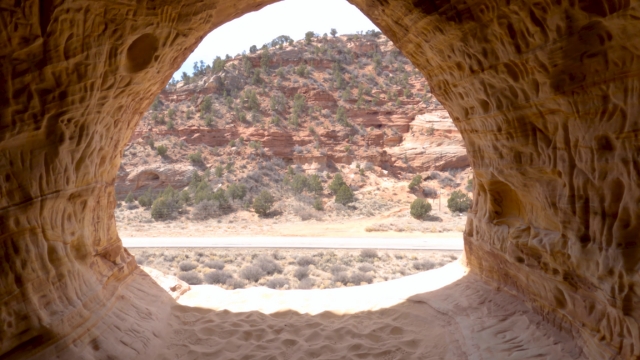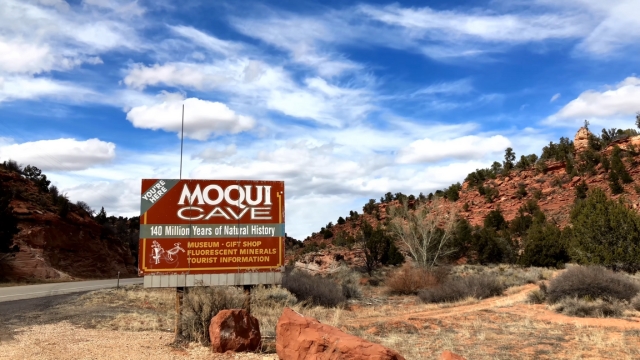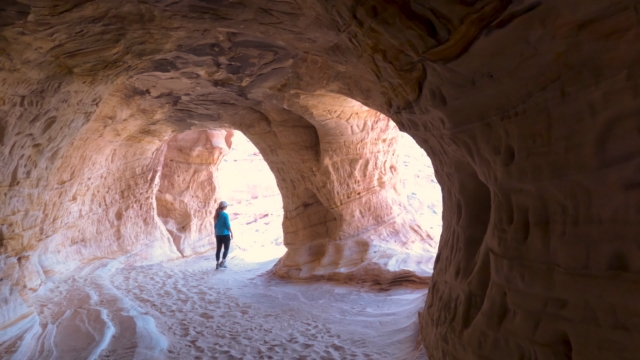If you walk into the Moqui Caverns today, you’ll find more than just a photogenic sandstone hollow.
Inside are smooth, hand-carved sandstone chambers, remnants of old sand-mining operations, dusty alcoves lit by sunlight filtering through the openings, fine-grained sand underfoot, and walls etched with both natural erosion and human activity.
The caverns are not ancient natural caves in the traditional sense; they’re man-made tunnels cut into the Navajo Sandstone during the mid-20th century. Today, they serve as a unique mix of geological showcase, historical curiosity, and Instagram backdrop.
How the Moqui Caverns Were Formed
The Moqui Caverns near Kanab, Utah, are carved directly into Navajo Sandstone – rock that was originally formed from vast ancient desert dunes some 180 million years ago. The sweeping layers visible inside tell the story of shifting winds, dune migration, and sediment compression over millions of years.
The current hollowed-out chambers, however, are the work of miners in the 1970s who excavated silica-rich sand for glass production. Their work left behind large, interconnected rooms and passageways, some tall enough to stand upright, others narrowing to knee-height crawl spaces.
What You’ll See Inside
Walking in, you immediately notice the temperature drop – the sandstone walls hold cool air, making it a welcome break from the desert heat. The light changes dramatically through the day; in the morning and late afternoon, beams of sunlight pour in at sharp angles, igniting the golden and orange hues of the walls.
The floors are soft with fine sand, giving the feeling of walking on a dry beach. In some spots, you can see remnants of pick marks from the original mining tools. Graffiti, both modern and decades old, is etched into some areas, though not always welcomed by preservationists.
Feature
Description
Notable Detail
Wall Texture
Smooth and rippled sandstone layers
Shows ancient wind-blown dune patterns
Floor
Loose, fine silica sand
Soft underfoot, beige to pale pink
Light Play
Shifting sunbeams through openings
Best for photography, mid-morning or sunset
Alcoves
Smaller side chambers
Offer unique angles for photos
Mining Marks
Visible in certain areas
Evidence of 1970s sand extraction
The Geological Side

The Navajo Sandstone inside the Moqui Caverns displays cross-bedding – slanted layers that were once wind-blown dunes. These structures not only tell scientists about ancient desert climates but also create visually striking patterns for visitors.
The colors range from pale cream to deep orange, a result of iron oxide staining within the stone. In some areas, you’ll spot small nodules and concretions – hard mineral clusters that formed as groundwater moved through the sandstone.
Rock Feature
Cause
Visual Effect
Cross-bedding
Ancient wind-dune migration
Diagonal stripes and waves in the rock
Iron Oxide Staining
Oxidation of iron-rich minerals
Warm red, orange, and yellow tones
Concretions
Mineral deposits around a nucleus
Small spherical or oval nodules
Human History Inside the Caverns
Though they may look ancient, the Moqui Caverns are tied to a relatively recent chapter of local industry. Miners in the 1970s were extracting sand with a high silica content, primarily for glassmaking. When the operation ended, the empty chambers became a curiosity for travelers.
Over time, locals and visitors began using them as a cool retreat from the desert heat, a photoshoot location, and a quick stop along U.S. Highway 89. There is also a nearby Moqui Cave Museum – unrelated in origin but often confused with the caverns – that showcases Native artifacts, minerals, and geological displays.
Stepping Inside: Sights, Sounds, and Sensations
View this post on Instagram
Walking in from the bright desert sun, the first thing you notice is the temperature change – the stone walls trap coolness, making the caverns feel like nature’s own air conditioning. Your shoes sink slightly into the powdery sand, and every movement stirs up a faint dust cloud that dances in the sunbeams.
The walls themselves are mesmerizing. Layers of ancient dunes tilt at dramatic angles, each layer a frozen wave of sand turned to stone. Iron-rich minerals give some stripes a deep red hue, while others remain pale gold.
The walls aren’t perfectly smooth – here and there, you’ll see the marks of mining tools, evidence of the people who transformed the cliff face into this honeycomb of rooms.
And then there’s the light show. Depending on the time of day, sunlight floods the main chamber or slips in as narrow shafts. At golden hour, the colors are so rich they almost look painted on.
Myths, Legends, and Confusion with the Moqui Cave

Because of their name, some visitors confuse the Moqui Caverns with the nearby Moqui Cave Museum – a former speakeasy-turned-geological-and-cultural exhibit. The museum houses Native American artifacts, dinosaur tracks, and minerals, but it’s separate from the caverns.
There’s also a persistent local myth that the caverns were used as Native American dwellings or storage sites, but there’s no archaeological evidence to support this. The confusion likely comes from the fact that other parts of southern Utah do contain Ancestral Puebloan cliff dwellings, and the term “Moqui” itself was historically used (controversially) to refer to the Hopi people.
Why People Visit Today
While the Moqui Caverns are relatively small compared to national park attractions, they have a certain draw:
- Easy roadside access – just off U.S. 89
- Photographic appeal – striking colors and textures without a long hike
- Cool refuge – a break from the desert heat
- Historical curiosity – seeing the mix of mining scars and natural sandstone
For photographers, the caverns are a dream in late afternoon when warm sunlight streams through the entrances. For families on a road trip, they’re a quick adventure that doesn’t require a full day’s planning.
If You Plan to Go
Tip
Why It Matters
Wear sturdy shoes
The sand hides uneven ground and small rocks
Bring a flashlight
The deeper chambers can be dim
Visit during golden hour
Best for photos
Don’t carve or paint the walls
Preserves the site for others
Check weather
Rain can make nearby slopes muddy and slick
Visiting Tips
While the caverns are not officially managed as a park, they are open for public exploration.
- Footwear: Wear closed-toe shoes; the sand is fine but can hide uneven footing.
- Lighting: Bring a flashlight or phone light—some chambers are dim.
- Respect the site: Avoid adding graffiti or disturbing natural features.
- Best time: Mid-morning and late afternoon for the best light and cooler temperatures.
Tip
Why It Matters
Closed-toe shoes
Sand can shift over loose rock and debris
Light source
Some areas have no direct sunlight
Photography timing
Golden hour light enhances colors
Respect rules
Preserves the caverns for future visitors
The Bottom Line
@mlovvely Moqui Caverns, Kanab, Utah📍 How did we get so lucky to have this place to ourselves?!😍❤️ #moquicaverns#kanab#utah#kanabutah#nature#naturetiktok#travel#traveltiktok#redrock#southernutah#explore#exploreutah#adventure#adventureutah#fyp#foryourpage#beautiful#serene#sunshine#blueskies#utahcheck#sandcaves ♬ The Night We Met – Marianne Beaulieu
Inside the Moqui Caverns, you’ll find a mix of natural beauty and human history: cool, sandy chambers cut into 180-million-year-old Navajo Sandstone, shaped both by ancient winds and by miners just a few decades ago.
The result is a surreal blend of geology and industry, wrapped in the warm desert colors of southern Utah – a reminder that sometimes the most striking “natural wonders” have a very human backstory.

